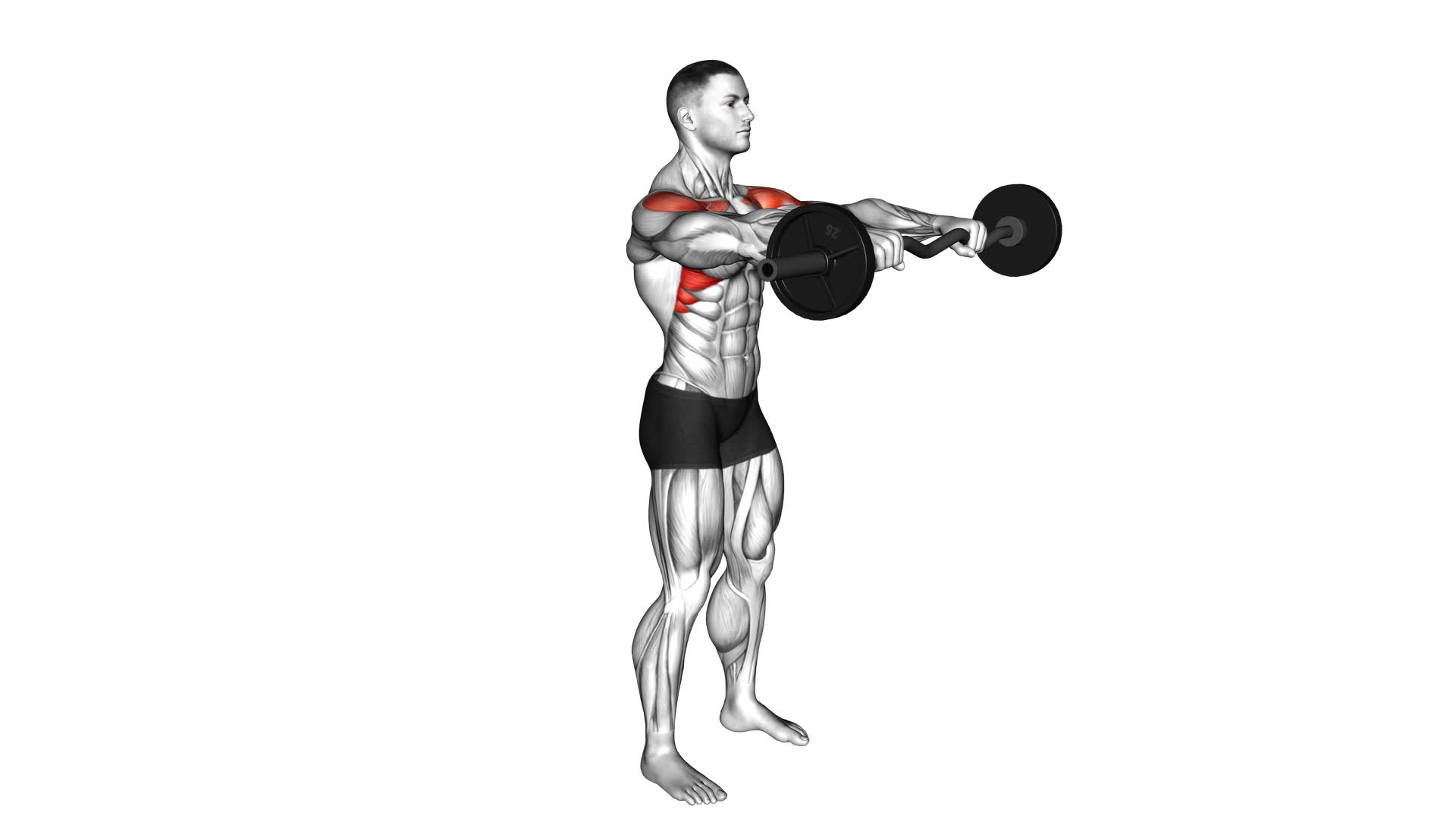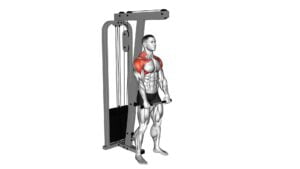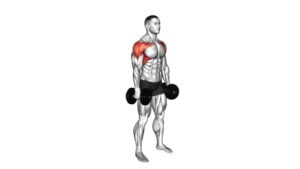EZ Bar Standing Front Raise – Video Exercise Guide & Tips

Are you looking for a new exercise to target your shoulders? Look no further than the EZ Bar Standing Front Raise.
Watch This Exercise Video
This video exercise guide and tips will show you the proper form and technique to maximize your results. Avoid common mistakes and learn how to increase the intensity of the exercise.
Whether you're a beginner or advanced, modifications for different fitness levels are included. Stay safe with our safety precautions and guidelines.
Get ready to strengthen those shoulders!
Key Takeaways
- Targets key muscle groups in the upper body, including deltoids, traps, and triceps
- Offers various variations to challenge muscles in different ways
- Improves shoulder stability and helps prevent shoulder injuries
- Enhances overall shoulder function
Benefits of the EZ Bar Standing Front Raise
You will experience increased shoulder strength and stability through the EZ Bar Standing Front Raise. This exercise targets several key muscle groups in your upper body, including the deltoids, traps, and triceps. The EZ Bar Standing Front Raise is a versatile exercise that offers various variations to challenge your muscles in different ways. By adjusting the grip width on the EZ bar, you can target different parts of your shoulders and arms.
One variation of the EZ Bar Standing Front Raise is the close grip variation. By holding the EZ bar with a narrow grip, you'll engage your front deltoids more intensely. This variation is great for building strength and size in your shoulders.
Another variation is the wide grip variation, where you hold the EZ bar with a wider grip. This targets the lateral deltoids and helps to develop broader shoulders.
In addition to targeting multiple muscle groups, the EZ Bar Standing Front Raise also improves shoulder stability. By holding the bar in front of your body, you're forced to stabilize your shoulder joints throughout the movement. This can help prevent shoulder injuries and improve overall shoulder function.
Now that you understand the benefits of the EZ Bar Standing Front Raise, let's move on to the proper form and technique for this exercise.
Proper Form and Technique for the Exercise
To perform the EZ Bar Standing Front Raise with proper form and technique, begin by grasping the EZ bar with an overhand grip at shoulder-width distance apart. Keep your feet shoulder-width apart, engage your core, and maintain a slight bend in your knees throughout the exercise. Now, lift the EZ bar in front of you, maintaining control and a slow, controlled motion.
Proper technique is crucial for maximizing the effectiveness of the EZ Bar Standing Front Raise and minimizing the risk of injury. Here are some key points to keep in mind:
- Keep your arms straight throughout the movement, with a slight bend in your elbows to avoid locking them out.
- Raise the EZ bar to shoulder height, making sure to avoid swinging or using momentum to lift the weight.
- Focus on maintaining a controlled and smooth motion, both during the upward and downward phases of the exercise.
By performing the EZ Bar Standing Front Raise with proper technique, you can effectively target and activate the muscles in your front shoulders (anterior deltoids). Additionally, this exercise also engages the muscles in your upper chest and upper back to a lesser extent.
Common Mistakes to Avoid While Performing the EZ Bar Standing Front Raise
When performing the EZ Bar Standing Front Raise, it's important to pay attention to your grip and wrist position. Make sure to hold the bar with a firm grip and keep your wrists straight throughout the movement to avoid any strain or discomfort.
Additionally, be mindful of your elbow alignment and ensure that they're in line with your shoulders.
Lastly, focus on maintaining a full range of motion by raising the bar all the way up to shoulder level and lowering it back down without swinging or using momentum.
Grip and Wrist Position
Maintain a neutral grip and proper wrist alignment while performing the EZ Bar Standing Front Raise to avoid common mistakes. Ensuring the correct grip and wrist position is crucial for maximizing the benefits of this exercise and preventing injuries. Here are some important points to keep in mind:
- Grip strength: Hold the EZ bar with a firm grip, ensuring that your hands are evenly spaced apart. This will help engage your grip strength and provide stability throughout the movement.
- Forearm engagement: As you raise the bar, focus on keeping your wrists straight and in line with your forearms. Avoid bending your wrists or allowing them to drop, as this can cause strain on the joints and reduce forearm engagement.
Elbow Alignment
Continue focusing on your form by paying attention to your elbow alignment while performing the EZ Bar Standing Front Raise. Proper elbow alignment is crucial for maximizing the effectiveness of this exercise and preventing potential injuries.
To ensure correct alignment, keep your elbows slightly bent throughout the movement and avoid locking them out at the top. Another common error to avoid is allowing your elbows to drift out to the sides. Keep them in line with your shoulders to engage the targeted muscles properly.
Range of Motion
To optimize the effectiveness of the EZ Bar Standing Front Raise, ensure that you maintain a proper range of motion throughout the exercise. This won't only prevent injury but also target the muscles effectively.
Here are some common mistakes to avoid:
- Avoid swinging the barbell: Swinging the barbell during the front raise reduces the effectiveness of the exercise and increases the risk of injury. Focus on controlled movements.
- Don't lift too high: Raising the barbell above shoulder level can put unnecessary strain on the shoulder joint. Keep the movement within a comfortable range.
- Gradually increase difficulty: As you progress, you can increase the difficulty of the exercise by adding more weight or performing the exercise on an unstable surface.
- Target different muscles: Vary the grip width of the EZ bar to target different muscles. A wider grip will target the deltoids more, while a narrower grip will engage the biceps and forearms.
Tips for Increasing the Intensity of the Exercise
To increase the intensity of the EZ Bar Standing Front Raise, incorporate supersets with other upper body exercises. Supersets involve performing two exercises back-to-back without resting in between. This advanced technique not only challenges your muscles but also increases the overall intensity of your workout.
One way to incorporate supersets is by pairing the EZ Bar Standing Front Raise with exercises that target the same muscle group, such as the dumbbell shoulder press or the lateral raise. Performing these exercises consecutively will put additional stress on your shoulder muscles, leading to greater muscle activation and growth.
Another option is to pair the EZ Bar Standing Front Raise with exercises that target different muscle groups, such as the bent-over row or the tricep pushdown. This allows you to maximize your workout time and engage multiple muscle groups simultaneously.
In addition to supersets, you can increase the intensity of the EZ Bar Standing Front Raise by adjusting the weight load or the number of repetitions. Gradually increase the weight as your strength improves to keep challenging your muscles. You can also perform more repetitions or decrease the rest time between sets to make the exercise more challenging.
Remember to listen to your body and progress at a pace that's appropriate for your fitness level. Pushing yourself too hard without proper technique and form can increase the risk of injury. Always consult with a qualified fitness professional before attempting advanced techniques.
Modifications for Different Fitness Levels
Now let's explore some modification options to accommodate different fitness levels when performing the EZ Bar Standing Front Raise.
If you're a beginner, there are beginner-friendly modifications available to help you ease into the exercise.
For those at an intermediate level, there are variations that can challenge you further.
Advanced individuals can find adaptations that push their limits.
Let's take a closer look at these modifications and variations to ensure you can tailor the exercise to your specific fitness level.
Beginner-Friendly Modification Options
If you're a beginner looking to modify the EZ Bar Standing Front Raise exercise for different fitness levels, consider using lighter weights. Here are some modification options and beginner-friendly adaptations to help you get started:
- Decrease the weight: Start with lighter dumbbells or even just bodyweight to focus on form and technique.
- Use resistance bands: Attach a resistance band to the EZ bar and perform the front raise movement. This will provide less resistance and make the exercise more manageable.
By using lighter weights and incorporating resistance bands, you can gradually build strength and stability in your shoulders while minimizing the risk of injury.
These beginner-friendly modifications allow you to start at a comfortable level and progress at your own pace. As you become more confident and stronger, you can then move on to the intermediate level variations.
Intermediate Level Variations
For intermediate fitness levels, there are several modifications and variations you can incorporate into the EZ Bar Standing Front Raise exercise to challenge yourself further and continue progressing.
One modification is to increase the weight of the EZ bar to provide a greater resistance for your shoulder muscles.
You can also try performing the exercise on one leg to engage your core and improve stability.
Another modification is to add a pause at the top of the movement to increase time under tension.
Additionally, you can experiment with different grip positions, such as a wide grip or a narrow grip, to target different areas of your shoulders.
These intermediate modifications and technique refinements will help you build strength and improve your overall performance.
Now, let's move on to the advanced adaptations for experts.
Advanced Adaptations for Experts
To further challenge yourself and continue progressing, experts can incorporate advanced adaptations and modifications into the EZ Bar Standing Front Raise exercise. Here are some expert techniques and advanced modifications you can try:
- Increase the weight: Use a heavier EZ bar or add weight plates to the barbell to increase the resistance and challenge your muscles even more.
- Add a tempo variation: Slow down the movement by performing the front raise in a controlled and deliberate manner. This will increase the time under tension and make the exercise more challenging.
- Incorporate a pause: At the top of the movement, hold the position for a few seconds before lowering the barbell back down. This helps to increase the intensity and engage your muscles in a different way.
Safety Precautions and Guidelines for the EZ Bar Standing Front Raise
How can you safely perform the EZ Bar Standing Front Raise? When performing this exercise, it's important to take certain safety precautions to prevent injury and maximize muscle activation. Here are some guidelines to follow:
First, ensure that you have a firm grip on the EZ bar, with your hands positioned slightly wider than shoulder-width apart. This will provide stability and control throughout the movement.
Maintain proper form by keeping your back straight and your core engaged. Avoid using excessive momentum or leaning back to lift the bar, as this can strain your lower back.
To protect your shoulders, avoid lifting the bar too high. Aim to raise it to shoulder level or just slightly above, while keeping your elbows slightly bent. This will help to engage the front deltoids effectively while minimizing strain on the joints.
Remember to breathe throughout the exercise. Inhale as you lower the bar and exhale as you raise it, keeping a steady rhythm.
Start with a lighter weight and gradually increase the load as your strength and technique improve. This will help you avoid overexertion and reduce the risk of injury.
Frequently Asked Questions
Can the EZ Bar Standing Front Raise Help Improve Shoulder Strength and Stability?
Yes, the EZ bar standing front raise can be a beneficial exercise for improving shoulder strength and stability.
By incorporating shoulder stability exercises like front raises into your workout routine, you can target the muscles in your shoulders and upper body, helping to build strength and stability.
Front raises specifically target the front deltoids, which play a key role in shoulder stability.
This exercise can help improve your overall shoulder strength and stability, leading to better performance in various activities.
Is It Necessary to Use an EZ Bar for This Exercise, or Can I Use a Regular Straight Barbell Instead?
Using a regular straight barbell for the EZ bar standing front raise isn't recommended. The EZ bar is specifically designed to provide a more comfortable grip and reduce strain on your wrists.
It also places less stress on your shoulders and allows for a greater range of motion. By using an EZ bar, you can maximize the benefits of the standing front raise exercise while minimizing the risk of injury.
Can the EZ Bar Standing Front Raise Help Improve Posture and Upper Body Alignment?
Yes, the EZ bar standing front raise can definitely help improve your posture and upper body alignment. By targeting your shoulders and upper back, this exercise strengthens the muscles that support proper posture.
Compared to the dumbbell front raise, the EZ bar variation allows for a more comfortable grip and reduces strain on your wrists.
Incorporating the EZ bar standing front raise into a full body workout routine can provide numerous benefits, including improved shoulder strength and overall upper body stability.
Are There Any Alternatives or Variations to the EZ Bar Standing Front Raise That Target the Same Muscle Groups?
If you're looking for alternatives or variations to target the same muscle groups as the EZ bar standing front raise, there are a few options you can consider.
One alternative is the dumbbell front raise, which works the same muscles but with individual dumbbells instead of an EZ bar.
Another variation is the cable front raise, which provides constant tension on the muscles throughout the movement.
These variations can help add variety to your workout routine while still targeting the same muscle groups.
How Frequently Should I Include the EZ Bar Standing Front Raise in My Workout Routine for Optimal Results?
To achieve optimal results with the EZ bar standing front raise, it's important to consider the frequency of incorporating it into your workout routine. By doing this exercise consistently, you can effectively target the desired muscle groups.
However, determining the ideal frequency depends on your individual goals and fitness level. It's recommended to consult with a fitness professional who can provide personalized guidance tailored to your specific needs.
Conclusion
In conclusion, the EZ bar standing front raise is a beneficial exercise for strengthening the shoulders and upper body. By maintaining proper form and technique, avoiding common mistakes, and following safety precautions, individuals of all fitness levels can perform this exercise effectively.
With the tips provided, it's also possible to increase the intensity of the exercise for those seeking a more challenging workout. Incorporating this exercise into your routine can help improve overall strength and muscle definition.

Author
Years ago, the spark of my life’s passion ignited in my mind the moment I stepped into the local gym for the first time. The inaugural bead of perspiration, the initial endeavor, the very first surge of endorphins, and a sense of pride that washed over me post-workout marked the beginning of my deep-seated interest in strength sports, fitness, and sports nutrition. This very curiosity blossomed rapidly into a profound fascination, propelling me to earn a Master’s degree in Physical Education from the Academy of Physical Education in Krakow, followed by a Sports Manager diploma from the Jagiellonian University. My journey of growth led me to gain more specialized qualifications, such as being a certified personal trainer with a focus on sports dietetics, a lifeguard, and an instructor for wellness and corrective gymnastics. Theoretical knowledge paired seamlessly with practical experience, reinforcing my belief that the transformation of individuals under my guidance was also a reflection of my personal growth. This belief holds true even today. Each day, I strive to push the boundaries and explore new realms. These realms gently elevate me to greater heights. The unique combination of passion for my field and the continuous quest for growth fuels my drive to break new ground.







